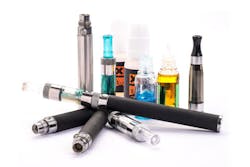This is a line I hear from patients in clinical practice more and more these days. E-cigarettes have become a hot trend in recent years with more and more individuals taking it up in place of or addition to traditional cigarettes. The question is how bad are they for you, really? There is so much information swirling around in the smoke and fumes it’s hard to tell the difference from fact and fiction. And do we really know the long-term effects on the oral cavity as well as overall health?
Vaping devices are an electronic handheld device that vaporizes flavored liquid for inhalation. The liquid may or may not contain nicotine They are a relatively new trend and require more research to consider the long term effects on the oral cavity as well as overall health.
Background
The e-cigarette was invented by a Chinese scientist in 2003 and has become a growing trend worldwide, especially in American society since its introduction in 2006. Vape pens, hookah pens, and e-cigarettes are all types of electronic nicotine delivery systems (ENDS) available to the American public. They utilize a nicotine-containing liquid that also includes propylene glycol, glycerin, an array of flavoring choices, and other ingredients. In 2016 the FDA began to regulate the manufacture, distribution, labeling, and sales of ENDS to the American public.
The electric component of e-cigarettes and vaping devices converts the liquid into an aerosol. All ENDS contain three basic parts—a battery, a liquid-containing cartridge, and a heating element.
The e-liquid may come prepared in a preloaded cartridge for insertion into the device; it may also be mixed specifically at a store or using a DIY kit. The nicotine levels can range from 0–36 mg/ml, depending on the user’s choice, with the vape system allowing the individual to customize the level of inhalation.
READ MORE | FDA to ban sale of e-cigarettes to minors, enact other tobacco product regulations
Use among young people and growing FDA regulations
Many individuals vape as a form of nicotine replacement while trying to quit cigarettes; for others, vaping started as solely recreational. According to FDA statistics, 3 million middle and high school-age students were users of ENDS in 2015, which represents an increase from 2.46 million in 2014. ENDS are the most commonly used nicotine product among youth with 16% of high school and 5.3% of middle school students admitting to using the products.1 The FDA cites the increase from 1.5% to 16% of high school students in the years from 2011 to 2015, with most students (81%) stating the availability of many choices of appealing flavors as the primary appeal of use.1 In my experience in clinical practice, most users are teens and twenty somethings, and many are left to believe vaping is harmless.
The FDA has now mandated all e-liquid products feature the following warning: “WARNING: This product contains nicotine. Nicotine is an addictive chemical.” In the instance the e-liquid does not contain nicotine the FDA still required the following warning be on the product: “This product is made from tobacco.” Many states have banned cigarette smoking in public places; the popularity of ENDS has been controversial, raising the question of whether the second-hand vapors are harmful or if it should be allowed in public places. Many states have passed or considering passing regulations banning vaping devices in public places where it may be harmful or bothersome to others.
READ MORE | Research analysis examines perio's link to lung cancer
Effects on the oral cavity
Like cigarettes, the aerosol first contacts the oral cavity when at its hottest. Studies have shown e-liquids to contain such toxins as diethylene glycol, which is also used in antifreeze, lead, and chromium, among others.2 Studies also have shown the menthol additive in e-cigarette liquids have a negative effect, as conventional cigarettes do, on the epithelial cells as well as the fibroblasts within the periodontal ligament.3 With this connection, it is worthwhile to take note and educate patients of the risks of electronic nicotine devices and the potential risks associated with use.
The effects on the oral cavity can vary depending on the frequency, type, and individual response. Clinically, I have seen everything from stomatitis to what appears as chemical burns. The most common effects of vaping I see are in the form of xerostomia, and often the patient may complain of a dry cough as well. They don’t realize the cough can be related to the inhalation of the vaporized liquid’s effect on the bronchioles of the lungs. Stomatitis will appear on the palate and looks similar to dark colored “pin pricks.” It is usually not sensitive to the patient. Ulcerations and what appear to be burns on the palate are often more sensitive but patients often don’t relate them to e-cigarette use since they don’t perceive the habit as harmful. Often I will spend the time to educate the patient about the potentially toxic ingredients within the e-liquid as well as utilize the intraoral camera to show the patient what I am able to see. You can talk and explain to the patient, but showing them the damage or pathology on the large screen of a computer monitor has a significant impact, especially on those who vape socially and believe it to be harmless fun.
READ MORE | Oral cancer screening: Where do we stand?
So you have educated and shown the big picture to the patient. Now what? Like conventional tobacco habits, e-cigarettes can be difficult to quit. Xerostomia can lead to an array of other complications in the ladder of oral health, including an increased decay rate. If a patient is not able or willing to give up the vaping habits, I will offer treatments for the side effects. For xerostomia and an increased caries rate, I will recommend a high fluoride and dry mouth solution for home use. I have found Colage PreviDent Dry Mouth to work well, and it is easy to use (it consists of 1.1% neutral sodium fluoride and is SLS free). If you add in too many steps for home use the individual may not be as compliant; however, by replacing regular toothpaste once daily with PreviDent, the individual gets the benefit of prescription strength Fluoride with the easy step of just brushing their teeth.
Vaping has become a trend in American society, especially to the younger population who often don’t think about the long term oral and overall health risks. It may be harder to identify those patients who use ENDS versus conventional cigarettes, but awareness on the clinician’s part and education can make the difference in life and overall health for years to come.
References
1. Vaporizers, E-Cigarettes, and other Electronic Nicotine Delivery Systems. U.S. Food and Drug Administration website.http://www.fda.gov/TobaccoProducts/Labeling/ProductsIngredientsComponents/ucm456610.htm. Updated June 3, 2016. Accessed June 28, 2016.
2. Holliday R, Stubbs C. A Dental Perspective On Electric Cigarettes: The Good, The Bad and The Ugly. OralHealth website. http://www.oralhealthgroup.com/features/a-dental-perspective-on-electronic-cigarettes-the-good-the-bad-and-the-ugly/. Published June 15, 2016. Accessed June 27, 2016.
3. Willershausen I, Wolf T, Weyer V, Sader R, Ghanaati, Willershausen B. Influence of E-smoking liquids on human periodontal ligament fibroblasts. Head Face Med. 2014;10:39. doi: 10.1186/1746-160X-10-39
Recommended reading
1. Raloff J. Vaping linked to host of new health risks. ScienceNews website.www.sciencenews.org/article/vaping-linked-host-new-health-risks. Published February 12, 2016. Accessed June 28, 2016.
For the most current dental content, click here.
Jamie Collins, RDH, CDA, resides in Idaho with her husband, Cory, and their four children. She currently works as a full-time hygienist as well as an educator at the College of Western Idaho. In addition, she acts as a content expert and contributor in multiple upcoming textbooks. She can be contacted at [email protected].







